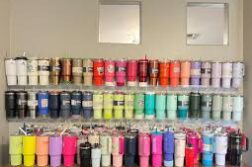The year of 2024 will go down in history as the year of ‘micro-trends’, an emerging concept marked by cycles of fast fashion and over-consumption, posing a threat to our individuality. Fashion is no longer used as a vehicle to express our identities, but as a tool used to blend in – how far are we willing to take this cycle before we lose the things that define us?



What are Micro-trends?
‘Micro-trend’ is a term that describes the arrival of trends which last a shorter period of time, for example a month rather than a season. We have seen a plethora of micro-trends pass us by over the year, such as the ‘Mob Wife’ aesthetic, or denim maxi skirts, as well as more bizarre makeup trends, such as ‘latte makeup‘ and ‘strawberry makeup‘ (both of which could be regarded as rebranded versions of previous trends, like the ‘brown smokey eye’ trend of the early 2000s). Leopard print is ‘in’, and cow print is ‘out’, so we must all run to fill our wardrobes with these patterns before we fall behind! Updated fashion is a symbol of status, and we can’t possibly afford to sacrifice our status!

The urgency of micro-trends, and the environmental damage that stems from it has become more and more dystopian, as we begin to delve into our unhealthy obsessions and our desperate desires to do anything we can to fit in.

A Social Media Crisis
The creation of an online community with whom you can share fashion and makeup advice is both fun and important; it allows women to have a safe space online in which they can express interest in topics that they have constantly been ridiculed for throughout history. However, there is an argument to be made that this phenomenon has been taken too far: the newfound existence and growing popularity of social media platforms has accelerated overconsumption, slowly undermining the creativity and individuality of humanity.
Although ‘beauty trends’ have been used to influence women for years, they were especially prominent in the past year due to the advancements in technology and social media. Nobody is subjected to these trends more than young girls. A study in 2022 conducted by the Pew Research Centre stated that 73% of teenage girls claim to use TikTok, while a further 69% use Instagram, and 63% have Snapchat.
‘Why is this such a significant issue?’, you may ask.
The increased exposure of social media to young people has directly caused a spike in fast fashion, as younger audiences are taught that a woman’s ‘desirability’ in the eyes of a man is their most worthwhile quality, and they can only reach this status if they buy into brands that help them resemble the ‘ideal woman’ (a woman who is ‘perfect’ according to the male gaze) as closely as possible.
Questions like ‘What are we wearing this Autumn?’ and ‘What bags are we bringing to school this year?’ have flooded ‘for you pages’, subconsciously emitting the idea that women should be keeping up with the unyielding nature of trends: younger girls expect to face bullying if they reuse clothing items, and women of all ages are taught to reinvent themselves a hundred times over so that they can remain new and exciting for the sake of men. We must stop this cycle, before our identities blend into one tasteless, overindulgent entity!
Exploitative Methods and Calculated Marketing
Fashion brands, armed with a few key buzzwords and manipulative marketing techniques, have transformed our ostensibly ‘civilised society’ into a lineup of identical beings, a factory pumping out machines who have lost their ability to think for themselves. And who can blame us: why would we need to search for our own style, when, with only a click, we face a bombardment of beauty brands dictating how we should act and what we should wear and how we should spend our money?
We should not have to sacrifice our individuality for the sake of embracing community!
The past year has been described as a year of rebranding, as successful beauty brands have been reintroducing trends from previous decades, such as the Y2K aesthetic, and harnessing social media platforms like Instagram to advertise these trends to women.
One might argue that this can be beneficial to many women in helping them find a style to express themselves, however, is it not also incredibly damaging? These trends often target young girls who are more vulnerable to the exploitative tactics of large businesses, and will spend copious amounts of money so that they can always be up to date on the latest beauty trend. Social media has been engineered to create a revolving door of ‘desirability’ – the portrayal of the ‘ideal woman’ is constantly changing to make it impossible for consumers to keep up.
Yet it is not only specific products that sell out due to the public’s blind faith in these figures: it is also lifestyles. For example, the model and influencer Nara Smith has recently faced controversy through her online presentation of traditional gender roles of a wife in a household. While she is not a stay-at-home mother, her content is tailored towards this audience, arguably encouraging this ‘picture-perfect’ lifestyle while failing to show the work that goes into each video that she posts – some have claimed that she has a marketing team behind each video, as well as official photography, a makeup artist and a fashion designer.

Although this may seem unimportant, it is reflective of a culture of ‘influencing’ in which those exposed to the public eye deceive their viewers into buying into a lifestyle or product without informing them of the negative aspects of it. We have all been conditioned to be persuaded into overconsumption through the language used on products. The phrases ‘pore-minimising’ and ‘hydrating’ can convince thousands to spend hundreds of pounds on products that they will only use once, despite the fact that we don’t fully understand what these buzzwords mean.
The effectiveness of influencers comes from their calculated use of language, and subtle manipulation tactics, that supply their power, while removing ours. Therefore, the importance of having agency in a world so easily controlled by randomly appointed figureheads can never be understated.
The Emergence of ‘Influencers’
The popularity of micro-trends can be widely attributed to the existence of ‘influencers’, content creators who had a large following and are therefore regarded as ‘trustworthy’ in their promotion of brands.

What many fail to realise is that these influencers are paid for the advertisement they do, and usually this is discretely – often, creators will neglect advertising laws by misleading audiences into believing that their persuasion towards a product is due to their personal opinion and the effectiveness of the product, rather than the money they will receive for reading from a script.

Environmental Effects
We have all heard of the destructive effects of fast fashion; we have read the statistics, listened to warnings surrounding endangered species, and seen how global warming will lead to the desecration of our world as we know it. However most of the public are so far removed from these effects that it is hard to imagine how one individual’s actions can contribute towards the destruction of our world as a whole.
And so it is important to remember that 85% of textiles end up in dumps each year, polluting bodies of water and harming aquatic life. It is necessary to learn that fast fashion makes up 10% of global carbon emission. We can not forget that we are not the only entities who live here. Our actions will not solely effect us! Before you buy those trending low-waisted jeans, remember there are millions of lives who are going to pay the consequences for your overindulgence. And finally, remember that you do not have to sacrifice your individuality for the sake of being part of a community.
Sofia Riaz 12A
